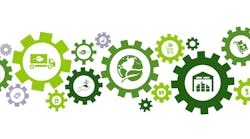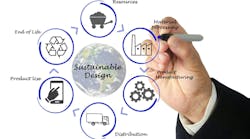Design, produce, manage and repair a path to circularity with your data
By, Eryn Devola, vice president of sustainability, Siemens Digital Industries
Industries around the globe are being challenged to accelerate a shift toward low-carbon and no-carbon operations. In any given sector, industrial production can contribute to nearly 20% of CO2 emissions; however, this shift is not exclusively driven by mounting environmental regulations and consumer demands for green products. Making a business sustainable creates opportunities to become a market leader and reap financial dividends.
According to Accenture, companies that pursue value driven by both sustainability and digital technologies are 2.5 times more likely to be among tomorrow’s strongest businesses. Arriving at that future will require work, but there is a growing portfolio of digital tools to help any company start their journey toward decarbonization.
Decarbonization will not happen in a vacuum. Every process, in every company, of every industry will need to be analyzed and optimized to reach a sustainable future. Businesses will need to harness their data and collaborate with partners, suppliers and distributors across the value chain to make resource-efficient, sustainable decisions that respect the complete life cycle of their products. And as materials become more valuable, whether intrinsically or artificially through regulatory intervention, circularity will become a driving force in many manufacturing businesses.
The urgency of decarbonizing the industrial sectors and manufacturing should not be underestimated. It needs to happen rapidly. For that reason, it is important to focus on the actions with the greatest impact. Any number of processes a product requires can contribute, starting with raw materials to end-of-life disposal, making data a valuable commodity in the drive for decarbonization. How energy efficient are the machines on the shop floor? Was the metal ore mined and refined sustainably? Is there a more efficient route logistics operations can take? And what becomes of the product after its useable life has come? These questions require businesses to tap into collective intelligence established in the digital twin to enable global sustainability optimizations along the entire value chain.
System-of-systems approach
The first step is creating transparency; the data being created across the enterprise needs to be readily accessible—both in human-readable and machine-readable formats. Traditionally that included data from each of the engineering domains working on a product (mechanical, electrical, electronics and software), and even some connection to the supplier network. But, to truly comprehend the complexity of decarbonizing a business and making it sustainable, data collection needs to span from the early conceptual design of the product to the decommissioning of it at end of life. That requires a system-of-systems approach to digitally characterize the details and dependencies of such complex products, leading to actionable analysis and optimization.
The decisions being made rely on data from many different sources all converging in the digital twin of the product—simulation model data, manufacturing data, real-world usage information, material data, and carbon-footprint data. Only by building a comprehensive digital twin of the product and process can manufactures uncover and prioritize the greatest potential for optimization—following the data across the lifecycle to generate substantial solutions for decarbonizing.
When a business can then drive intelligence across the entire product lifecycle into the digital twin, it can continuously learn and improve to provide the best product to the customer as efficiently as possible.
For example, many manufacturers rely heavily on electrical energy to power their processes—for motor drives, resistive heating, laser systems, and more. By understanding manufacturing as a system-of-systems, with data being fed, analyzed, and modeled for a variety of processes, the entire manufacturing enterprise (from motors to lines, plants and networks) can be orchestrated to use the electricity as efficiently as possible. For instance, a large automotive OEM cut energy consumption of their manufacturing line by nearly 30% by optimizing the power states of machines on the floor. Rather than letting the motors time-out on their default schedule, an optimized timing could be applied that maximized the readiness of the next component with the energy wasted from remaining idle.
This is a powerful example of how simulating the system-of-systems on the shop floor provides actionable and significant savings on energy consumption—directly correlated with energy costs and emissions from the regional power grid. A company may also want to combine this energy data with existing production data to improve overall productivity of the plant in tandem with energy use, increasing the per-product efficiency even more. Adopting a system-of-systems approach establishes the foundation to make these optimizations possible.
Managing ecosystem complexity
Even a company that optimizes its own production system internally still has more to improve because every industrial company is part of a larger network with suppliers, distributors, and other partners who all influence sustainability performance and decarbonization potential.
For example, a manufacturing process could be engineered to be carbon-neutral, or even carbon-negative, but if a supplier providing sub-systems or raw materials is not reporting their carbon data, it will be difficult to certify the environmental sustainability of that product. Providing this transparency across the lifecycle of a product is a growing requirement for many consumers in a variety of industries, but it is also gaining the eye of investors as ESG (environmental, social, and government) holdings and among regulators looking to curb carbon emissions.
Transparency in the value chain provides the shared understanding to collaboratively make decisions with the entire supplier network to reduce carbon emissions and build the framework for more complex optimizations later in time. For a larger enterprise, this could lead to a decision of whether to refine a raw material closer to the source to eliminate the extra emissions from transporting more mass, or to process the materials further away with better extraction efficiency. Making the best decision demands data that reflects the carbon intensity and material utilization across the complete value chain.
These difficult decisions can even extend to the early design of the product, with material selection and the expected usage life of a component—wear-components such as automobile brake disks, the gears of wind turbines, or the batteries in electric vehicles would benefit from improved repairability or recyclability characteristics. Long-life components could benefit overall decarbonization through stronger materials that do not need to be replaced over the life of a product—more energy can be invested in manufacturing to avoid usage emissions.
By connecting industrial ecosystems, companies get the transparency and intelligence needed for collective action with all their stakeholders to meet overall sustainability targets. Understanding carbon intensity and resource utilization up and down the value chain, from suppliers and distributors to energy producers and recyclers, enables easily exchangeable information to further inform your digital twin. Then a business can broach new opportunities to partner, co-create and sustainably grow together.
The goal is circularity
Understanding and optimizing a product for decarbonization targets over the complete lifecycle is a noble goal, but it is not simply a change in mindset for methods to engineer and manufacture the product. Designing products for disassembly and the re-use of their components is a culmination of the previous principles, to establish a circular material flow. Circularity is a goal to aspire to for many industries and businesses that need to go sustainable—products should be used as long as possible to minimize the emissions associated with manufacturing.
Processes can only be made so efficient, so reducing the number of products is critical. That can be through repairing and replacing worn-out components in a complex product, reusing viable materials in a second life, or recycling materials that cannot be used directly. Doing so requires work across the lifecycle, whether that is designing the product for modularity to easily upgrade a system with new and more durable components or using readily recyclable materials and predictive maintenance to extend the usage life of the product.
Circularity is not only a pathway to decarbonization, but it can be a great financial incentive to in many industries that rely on expensive and rare materials. It is already a practice used by some electronics companies—harvesting the precious metals and materials from devices, to be re-used in the next-generation product. In fact there is an entire industry looking to adopt circularity—batteries—and there are customers already implementing cutting-edge digital tools to make it happen at a larger scale.
Redux Recycling handles the lithium-ion batteries commonly found in everything from cell phones to electric vehicles. As the demand for the material continues to grow, the value of the raw materials is growing, which makes both a business and sustainability case for recycling and circularity. Redux came to Siemens to create an innovative, high-throughput recycling plant for different mass flows of lithium-ion batteries. That required sorting recovered materials from all types of batteries—electrics cars, e-bikes, power tools, and household products—before extracting the valuable lithium. Through digitalization and a data-first approach to sustainability and efficiency, throughput was increased from 2,000 to 10,000 tons per year, and they are well on their way to 30,000 tons per year.
Conclusion
Decarbonization may not be a simple task for any business, but applying the power of digital solutions is a deployable first step toward a sustainable business. On top of enabling accelerated innovation in already complex products, interconnected digital tools provide the transparency into a business to best optimize between cost, quality, time and sustainability. Modern tools provide the space to design, manufacture, use, and decommission products collectively with partners and suppliers around the world.
Collaborative and data-driven decision making will be critical in building the successful businesses of tomorrow—ones that can implement circular material usage, others that can become carbon neutral, and even more that can make existing operations as efficient as possible.
Wherever a business is starting on the path to decarbonization, there are digital tools and physical solutions that can help make it happen. It starts with informing your digital twin with data from across the product lifecycle and ecosystems, and then evolves toward turning that data into collective intelligence and making informed decisions on your journey to net zero.



